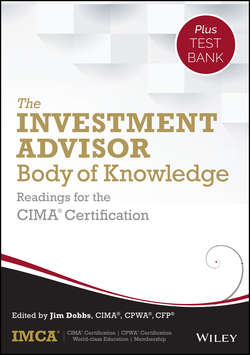Читать книгу The Investment Advisor Body of Knowledge + Test Bank - IMCA - Страница 36
На сайте Литреса книга снята с продажи.
CHAPTER 3
Statistics and Methods
Part IV Distributions
ОглавлениеNormal Distribution
The normal distribution is probably the most widely used distribution in statistics, and is extremely popular in finance. The normal distribution occurs in a large number of settings, and is extremely easy to work with.
In popular literature, the normal distribution is often referred to as the bell curve because of the shape of its probability density function (see Figure 3.7).
FIGURE 3.7 Normal Distribution Probability Density Function
The probability density function of the normal distribution is symmetrical, with the mean and median coinciding with the highest point of the PDF. Because it is symmetrical, the skew of a normal distribution is always zero. The kurtosis of a normal distribution is always 3. By definition, the excess kurtosis of a normal distribution is zero.
In some fields it is more common to refer to the normal distribution as the Gaussian distribution, after the famous German mathematician Johann Gauss, who is credited with some of the earliest work with the distribution. It is not the case that one name is more precise than the other as with mean and average. Both normal distribution and Gaussian distribution are acceptable terms.
Normal distributions are used throughout finance and risk management. Previously, we suggested that log returns are extremely useful in financial modeling. One attribute that makes log returns particularly attractive is that they can be modeled using normal distributions. Normal distributions can generate numbers from negative infinity to positive infinity. For a particular normal distribution, the most extreme values might be extremely unlikely, but they can occur. This poses a problem for standard returns, which typically cannot be less than –100 percent. For log returns, though, there is no such constraint. Log returns also can range from negative to positive infinity.
Normally distributed log returns are widely used in financial simulations, and form the basis of a number of financial models, including the Black-Scholes option pricing model. As we will see, while this normal assumption is often a convenient starting point, much of risk management is focused on addressing departures from this normality assumption.
Because the normal distribution is so widely used, most practitioners are expected to have at least a rough idea of how much of the distribution falls within one, two, or three standard deviations. In risk management it is also useful to know how many standard deviations are needed to encompass 95 percent or 99 percent of outcomes. Table 3.2 lists some common values. Notice that for each row in the table, there is a “one-tailed” and “two-tailed” column. If we want to know how far we have to go to encompass 95 percent of the mass in the density function, the one-tailed value tells us that 95 percent of the values are less than 1.64 standard deviations above the mean. Because the normal distribution is symmetrical, it follows that 5 percent of the values are less than 1.64 standard deviations below the mean. The two-tailed value, in turn, tells us that 95 percent of the mass is within +/–1.96 standard deviations of the mean. It follows that 2.5 percent of the outcomes are less than –1.96 standard deviations from the mean, and 2.5 percent are greater than +1.96 standard deviations from the mean. Rather than one-tailed and two-tailed, some authors refer to “one-sided” and “two-sided” values.
TABLE 3.2 Normal Distribution Confidence Intervals
Application: Monte Carlo Simulations: Creating Normal Random Variables
While some problems in risk management have explicit analytic solutions, many problems have no exact mathematical solution. In these cases, we can often approximate a solution by creating a Monte Carlo simulation. A Monte Carlo simulation consists of a number of trials. For each trial we feed random inputs into a system of equations. By collecting the outputs from the system of equations for a large number of trials, we can estimate the statistical properties of the output variables.
Even in cases where explicit solutions might exist, a Monte Carlo solution might be preferable in practice if the explicit solution is difficult to derive or extremely complex. In some cases a simple Monte Carlo simulation can be easier to understand, thereby reducing operational risk.
In this chapter we will explore two closely related topics, confidence intervals and hypothesis testing. At the end of the chapter, we will explore applications, including value at risk (VaR).
